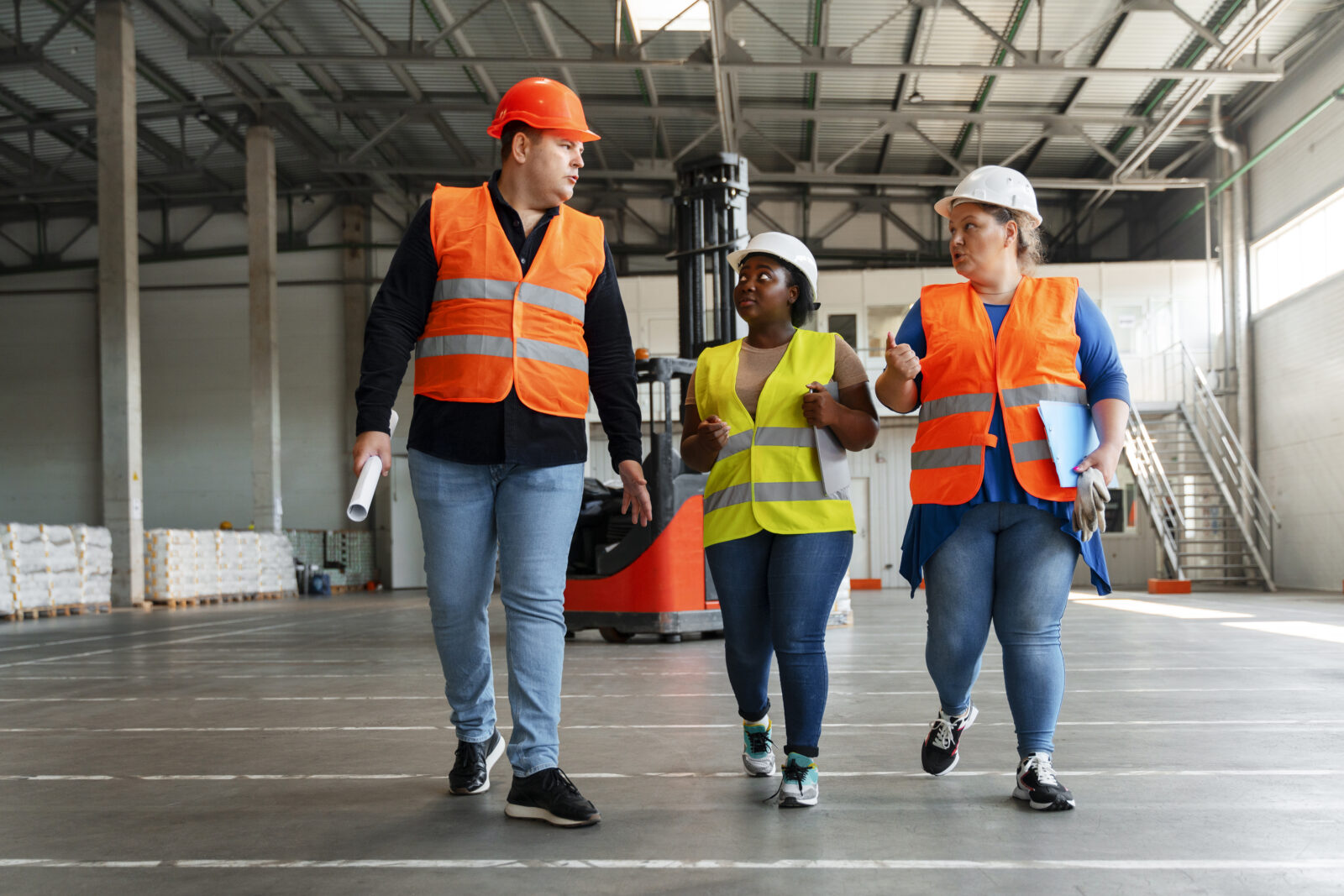
Personal Protective Equipment (PPE) for Construction Safety
Introduction Personal Protective Equipment (PPE) is important for keeping building workers safe from the many dangers that are present. Because...

Get 20€ off on your first order!
There are a lot of potential dangers and emergencies on construction sites. A reliable emergency response plan is essential for preventing harm to property and employees. To ensure that personnel are prepared for a wide range of emergencies, a well-organised emergency response plan incorporates preparation measures, lucid communication protocols, and regular training. In order to respond quickly and organizedly to emergencies on a construction site, this article goes over the basics of creating one.
Construction site emergency preparation involves planning, training, and equipping workers to handle crises and disasters. This entails creating detailed plans and processes to preserve people, property, and business continuity during natural and man-made calamities.
Emergency is a sudden, urgent situation that necessitates rapid response. It might occur abruptly due to accidents or medical problems.
Disasters are severe emergencies that cause extensive damage, suffering, or loss, but they may have enduring consequences on communities and people.
Whatever we call them, crises and disasters demand emergency preparedness.
In construction sites, emergency preparedness is being proactive and ready to manage unforeseen incidents to save lives, reduce damage, and resume normal operations. The following are crucial to disaster preparedness:
The COSH Training Program lists two crises. Human-caused emergencies include chemical spills, explosions, and infrastructural breakdowns. Natural disasters include earthquakes, floods, and harsh weather. Both crises demand immediate response to reduce damage.
The following are common situations and calamities that Filipino construction workers may face. Always remember that workers can manage situations and minimise their effects by being prepared and following procedures.
Typhoons cause floods and structural damage with high winds and heavy rain.
Take any loose items and equipment to safe spots. Follow weather reports and don’t work until it’s clear.
Heavy rainfall or typhoons can cause significant flooding, especially in low-lying locations, affecting site operations and posing drowning concerns.
Get higher and avoid soggy regions. Turn off all electronics to avoid electrocution.
Rapid ground shaking from tectonic movements can cause structure collapses and ground ruptures.
Drop, cover, and hold on during shaking. After the earthquakes stop, escape to open areas away from structures and follow emergency coordinator suggestions.
Electrical problems, combustible materials, and welding can produce fires, causing burns and smoke inhalation.
Activate the fire alarm, call for aid, and use a trained extinguisher. Leave immediately and go to the assembly point.
Leaks of fuel or chemicals could hurt people and the environment.
Please call the emergency services and leave the area. For control and cleaning, read the Material Safety Data Sheets and wear the right gear.
The Material Safety Data Sheet (MSDS) tells you how to carefully work with a product.
Accidents involving building tools and vehicles might be fatal.
Guard the accident site and attend to injured victims. Tell emergency services and look into ways to stop recurrence.
Deliberate violence or sabotage could damage property as well as persons.
Immediately evacuate and inform security. Keep locked down and wait for officials.
One can get major harm or death from building or scaffold collapse.
Notify emergency personnel and start your immediate evacuation. At the assembly point, headcount and give first help.
Construction sites can be dangerous due to poisoning.
First assistance, emergency calls, and decontamination are steps.
Construction site emergency preparation requires good communication. It quickly distributes alerts and cautions, allowing workers to defend themselves.
Clear instructions guide workers through situations without panic or confusion. Communication keeps team members safe following incidents and ensures accountability.
Finally, communication helps coordinate recovery and normal operations after an incident. Construction site crises need good communication for safety, coordination, and resource management.
Emergency preparedness requires good communication. It safeguards lives and property with timely alarms, coordinated actions, clear instructions, and effective resource allocation.
Multiple Channels: Use two-way radios, smartphones, warning systems, and megaphones to reach everyone.
Backup networks: Use generators and batteries to keep communication networks running during power outages.
Regular communication exercises familiarise personnel with emergency protocols and assure system functionality.
Clear Protocols: Determine who to contact, what to say, and how to document and disseminate communications.
Training: Teach staff how to utilise communication technology and write clearly in crises.
TIP: Department heads must count everyone during exercises. For employees, close windows, doors, and lights as assigned.
An emergency process is a set of steps to be taken in a precise order in response to a predicted emergency that threatens health, life, property, or the environment.
Emergency procedure is also the removal of people from dangerous situations that could endanger their lives or health to a safe area or assembly point.
Construction workers are safer and more prepared with a clear general emergency plan. To coordinate emergency response, this strategy comprises effective warning systems, thorough education and training, and defined specific roles.
Weather, natural catastrophe, and other emergency warnings of Philippine authorities. Alerts enable quick reaction and planning.
Notifications for building administration or security to the emergency response team also help. These alerts tell staff members and guests to meet at a designated spot or flee.
Survival training prepares individuals and teams to deal with emergencies.
Staff members should practise evacuation routes and emergency procedures through regular fire drills. Responses to emergencies are practiced in these drills.
The heads of each department are responsible for keeping track of their employees during emergency drills and realistic scenarios. They need to make sure that everyone gets to the meeting places in one piece.
It is possible to notify workers to turn off all lights, windows and doors before they leave the building. The risks have been reduced and the evacuation is now safer as a result of these measures.
Preparing construction sites for emergencies requires the following steps.
Making sure all employees are aware of a construction site-specific emergency plan that addresses hazards and needs.
Because tailoring the pan to the environment and emergency considers all potential hazards and informs everyone of their roles and responsibilities.
Provide extensive training for staff and appoint qualified emergency responders.
Training ensures employees know how to respond to emergencies and that leaders guide actions and decisions.
Check dangerous areas and warning systems regularly.
Early risk assessment and emergency warning system reliability are achieved through frequent inspections.
Review the emergency plan regularly to reflect site, operational, and personnel changes.
The plan stays relevant and effective by addressing new hazards and incorporating lessons from previous drills or incidents.
This general evacuation procedure can help workers evacuate safely and orderly during fires, earthquakes, hazardous material spills, and other emergencies. Specific emergencies may require a different approach or guide.
Sound the Alarm: Sound the emergency alarm to warn site personnel to evacuate immediately.
Follow the Safety Officers or Safety Committee: Listen to and follow the evacuation coordinators’ instructions.
Secure Equipment and Work Areas: Only when safe. Close windows and doors to reduce hazards.
Avoid Running or Pushing: Move quickly and calmly to the nearest exit to avoid accidents.
Check for Stragglers: Clear restrooms, vacant rooms, and other areas and help anyone evacuate.
Avoid danger zones and ensure a smooth flow of people by following designated evacuation routes.
Go to Pre-Designated Assembly Points: Go directly to headcount locations.
Elevators may malfunction or be unsafe in emergencies, so use stairs instead.
Stay Clear: Once outside, move away from the building to avoid falling debris and allow emergency responders access.
Supervisors: Report to your supervisor or designated person for a headcount and instructions at the assembly point.
Stay at the assembly point until the safety committee or officer gives more instructions.
Help Emergency Responders: Give emergency responders any information they need.
We think emergency evacuation workers should prioritise orderly evacuation. Because staying calm and moving quickly without pushing or running prevents evacuation accidents and injuries. Workers reduce chaos so others can leave safely and efficiently. Controlled and systematic evacuation helps emergency responders manage the situation.
All other procedures are essential for a complete emergency response, but maintaining order during the evacuation is crucial for worker and site safety.
Construction site emergency operations require careful planning and organisation to respond quickly and efficiently. The following are essential for emergency safety and risk reduction.
ERT: Coordinate, manage, and make emergency policies.
Chain of Command: Maintain emergency leadership and responsibility.
Operational Support: Give staff roles for emergency response.
Emergency response roles and procedures should be clearly defined by the department.
Training: Educate workers on warning signs and instructions.
Responsibility: Assign property protection and system shutdown tasks.
Provide detailed systematic shutdown procedures with checklists and diagrams.
Backup Systems: Test backup communication channels regularly.
Emergency Numbers: Keep emergency numbers handy.
Fire equipment and utility shutoffs: Know their locations.
Medical Support: Provide on-site emergency medical services and supplies.
Finally, construction site safety requires a robust emergency response strategy. Proactive planning, frequent training, clear communication lines, and continual development may prevent emergency injuries and damage for construction organisations. Emergency response teams with enough resources and leadership train personnel for a range of emergencies. These procedures help construction sites run safely and effectively, even when unforeseen problems arise.
Thank you! You've signed up for our newsletter.



















Introduction Personal Protective Equipment (PPE) is important for keeping building workers safe from the many dangers that are present. Because...

Introduction Construction is among the most dangerous jobs, with many injuries and deaths. Construction worker safety is critical, and thorough...

Introduction Construction sites are inherently hazardous environments where maintaining safety is paramount. At the heart of ensuring safety on these...

Introduction Personal Protective Equipment (PPE) is important for keeping building workers safe from the many dangers that are present. Because...

Introduction Construction is among the most dangerous jobs, with many injuries and deaths. Construction worker safety is critical, and thorough...

Introduction Construction sites are inherently hazardous environments where maintaining safety is paramount. At the heart of ensuring safety on these...
Get 20€ off on your first order!
Save 30% by buying directly from brands, and get an extra 10€ off orders over €100
Save 30% by buying directly form brands, and get an extra 10€ off orders over €100